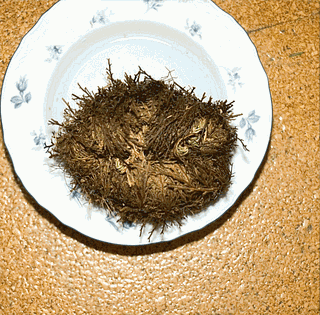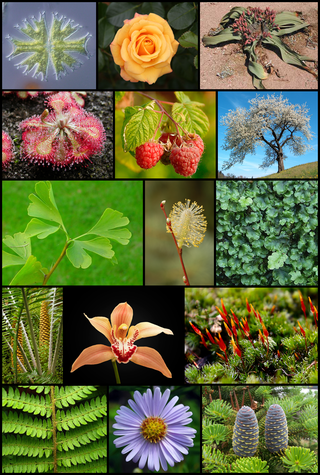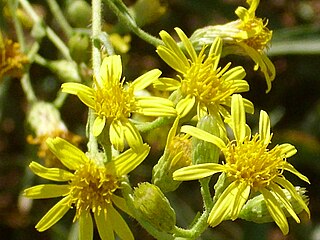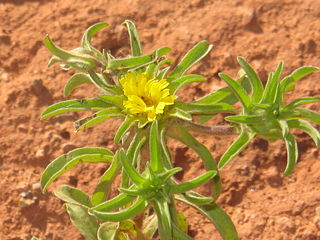
Robert Anthony Plant is an English singer and songwriter, best known as the lead singer and lyricist of the English rock band Led Zeppelin for all of its existence from 1968 until 1980, when the band broke up following the death of John Bonham, the band's drummer. Plant was inducted with the band into the Rock and Roll Hall of Fame in 1995.

Anastatica is a monotypic genus of plants in the family Brassicaceae containing the single species Anastatica hierochuntica. The plant is a small gray annual herb that rarely grows above 15 centimetres (6 in) high, and bears minute white flowers. It is a tumbleweed capable of hygroscopic expansion and retraction. However, it is not a true resurrection plant. because the plant's dead tissues do not revive and turn green.

A resurrection plant is any poikilohydric plant that can survive extreme dehydration, even over months or years.
Dinosaur plant is a common name for several plants and may refer to:

The Temple of Ares was a sanctuary dedicated to Ares, located in the northern part of the Ancient Agora of Athens. The Temple was identified as such by Pausanias but the ruins present today indicate a complex history. Ares had a temple somewhat like Athena's.

Asteriscus is a genus of flowering plants in the family Asteraceae.

Pallenis maritima is a herbaceous perennial in the family Asteraceae. The species is native to the Canary Islands, southern Portugal, the western Mediterranean, and Greece. It grows up to 30 cm high and 45 cm in width and produces yellow "daisy" flowerheads with darker yellow centres.

Forsskaolea tenacissima is a member of the non-stinging nettles genus Forsskaolea and is in the same family as the stinging kind, Urticaceae. Described as "looking like a tough character that does not want or need a caress", F. tenacissima makes its home where not many plant species survive, in stony soils, road edges, in the gravel wadi and "in the rock crevices and water-receiving depressions" above the stone pavements of the Hamadas.
A xerophyte is a species of plant that has adaptations to survive in an environment with little liquid water, such as a desert or an ice- or snow-covered region in the Alps or the Arctic. Popular examples of xerophytes are cacti, pineapple and some Gymnosperm plants.
Rose of Jericho or Jericho rose may refer to:

Plants are predominantly photosynthetic eukaryotes of the kingdom Plantae. Historically, the plant kingdom encompassed all living things that were not animals, and included algae and fungi; however, all current definitions of Plantae exclude the fungi and some algae, as well as the prokaryotes. By one definition, plants form the clade Viridiplantae which is sister of the Glaucophyta, and consists of the green algae and Embryophyta. The latter includes the flowering plants, conifers and other gymnosperms, ferns and their allies, hornworts, liverworts, and mosses.

Halothamnus hierochunticus is a species of the plant genus Halothamnus, that belongs to the subfamily Salsoloideae within the family Amaranthaceae,. It occurs in Southwest Asia and is partly considered as a weed.

Inuleae is a tribe of flowering plants in the subfamily Asteroideae.

Pallenis spinosa, commonly known as spiny starwort or spiny golden star, is an annual herbaceous plant belonging to the genus Pallenis of the family Asteraceae. The Latin name of the genus is derived from palea (chaff), referring to the chaffy receptacle, while the species name spinosa, meaning spiny, refers to the spiny bracts surrounding the flowers.

Tillinae is a subfamily of beetles in the family Cleridae, the checkered beetles.

Calblanque Regional Park, Monte de las Cenizas y Peña del Águila is a regional park in the south-east of Spain, and in this country in the autonomous community Región de Murcia. In this region, it is located in the municipalities Cartagena and La Unión. It is part of Sierra Minera, a mountain chain in the Baetic System.
Pallene was a celebrated deme of ancient Athens, frequently mentioned by ancient writers and in inscriptions. From the mythical story of the war of the Pallantidae against Theseus, we learn that the demes of Pallene, Gargettus, and Hagnous were adjacent. When Pallas was marching from Sphettus in the Mesogaea against Athens, he placed a body of his troops in ambush at Gargettus, under the command of his two sons, who were ordered, as soon as he was engaged with the army of Theseus, to march rapidly upon Athens and take the city by surprise, But the stratagem was revealed to Theseus by Leos of Agnus, the herald of Pallas, whereupon Theseus cut to pieces the troops at Gargettus. In consequence of this a lasting enmity followed between the inhabitants of Pallene and Hagnous.
Gargettus or Gargettos was a deme of ancient Attica. From the mythical story of the war of the Pallantidae against Theseus, we learn that the demoi of Pallene, Gargettus, and Agnus were adjacent. When Pallas was marching from Sphettus in the Mesogaea against Athens, he placed a body of his troops in ambush at Gargettus, under the command of his two sons, who were ordered, as soon as he was engaged with the army of Theseus, to march rapidly upon Athens and take the city by surprise, But the stratagem was revealed to Theseus by Leos of Agnus, the herald of Pallas; whereupon Theseus cut to pieces the troops at Gargettus. In consequence of this a lasting enmity followed between the inhabitants of Pallene and Agnus.
Agnus or Agnous, also Hagnus or Hagnous (Ἁγνοῦς) was a deme of ancient Attica. From the mythical story of the war of the Pallantidae against Theseus, we learn that the demoi of Pallene, Gargettus, and Agnus were adjacent. When Pallas was marching from Sphettus in the Mesogaea against Athens, he placed a body of his troops in ambush at Gargettus, under the command of his two sons, who were ordered, as soon as he was engaged with the army of Theseus, to march rapidly upon Athens and take the city by surprise, But the stratagem was revealed to Theseus by Leos of Agnus, the herald of Pallas; whereupon Theseus cut to pieces the troops at Gargettus. In consequence of this a lasting enmity followed between the inhabitants of Pallene and Agnus.

Asteriscus aquaticus is a species of flowering plant. The flower is part of the so-called "Asteriscus alliance".














